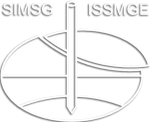Advances in solute diffusion through bentonite polymer composites
Advances in solute diffusion through bentonite polymer composites
Geosynthetic clay liners (GCLs) comprising bentonite-polymer composite (BPC) have been developed for use in containment applications where sodium bentonite (NaB) is likely to undergo chemical interactions that degrade barrier performance (e.g., an increase in hydraulic conductivity, k, for solutions of high ionic strength and/or extreme pH). Modelling the performance of a barrier system within the hydrogeological setting requires knowledge of both the k and the diffusion coefficients of the GCL. Although diffusion coefficients for NaB-GCLs for inorganic and organic contaminants have been well studied, understanding of the impact of polymer amendment on diffusion coefficients of BPC-GCLs remains limited. This paper provides a synthesis of data in the literature as well as ongoing studies focused on diffusion of inorganic contaminants through BPC. Based on experimental results to date, BPC may exhibit significantly lower k than NaB (e.g., by orders of magnitude) for a given solution, without also exhibiting lower diffusion coefficients than NaB. In fact, for some cases, diffusion coefficients of BPC were double to triple those of the NaB, whereas for other BPC-leachate combinations the opposite was true. Relative to NaB, the diffusion coefficients of BPCs are more variable and complex, due in part to how contaminants diffuse through and interact with the polymer hydrogel versus the bentonite fraction. Thus, reliable estimation of diffusion coefficient values of BPC-GCLs is more challenging than for NaB-GCLs and may require case-specific testing. Data for diffusion coefficients of BPC-GCLs for a range of leachates, BPC types, and test conditions (e.g., hydration, stress) is needed to allow for accurate transport analysis of barrier systems that utilize BPC-GCLs. In this regard, recent advances and future research directions also are identified within the paper.
Kristin Sample-Lord; Gretchen Bohnhoff; Shan Tong; D. Adeleke; B. Sayed Arafat Rahman
9th International Congress on Environmental Geotechnics (ICEG2023)
Geosynthetics for the Geoenvironment
Geosynthetics, Geoenvironmental Engineering, Contaminant Transport
https://doi.org/10.53243/ICEG2023-255
